Choosing the right fertilizer spreader isn’t just a mechanical decision—it’s agronomic. The equipment you choose directly affects how evenly nutrients are distributed, how efficiently inputs are used, and ultimately, how your crops perform. Whether you’re managing a row crop operation, hayfield, orchard, or food plot, the wrong spreader can lead to wasted inputs, nutrient deficiencies, and uneven growth.
Let’s dig deeper into key factors to consider when choosing a fertilizer spreader, with a focus on yield impact and how Newton Crouch equipment is engineered to help.
Spreader Application Style: Broadcast or Banded?
Broadcast Application
- Pros: Covers large areas quickly; ideal for top-dress or pre-plant applications.
- Cons: Can lead to nutrient losses via runoff, especially with urea or ammonium nitrate on bare ground.
Banded Application
- Pros: Places nutrients close to the root zone, increasing uptake efficiency and reducing loss.
- Cons: Requires more precision; may need slower ground speeds and narrower swaths.
Yield Impact:
Poorly timed or uneven broadcast applications can cause streaking, patchy growth, or underutilization of applied fertilizer. Banding in the root zone can significantly improve nitrogen-use efficiency, especially in starter fertilizers for corn or vegetables.
How Newton Crouch Helps:
Newton Crouch spreaders are designed to deliver a consistent spread pattern—our spread pattern deliver even broadcast application with constant coverage throughout the swath. The ability to fine-tune spinner speeds and chute setting ensures adaptability to your chosen application method. Newton Crouch spreaders can broadcast or band by simply adding removable and adjustable bander for focused banding.
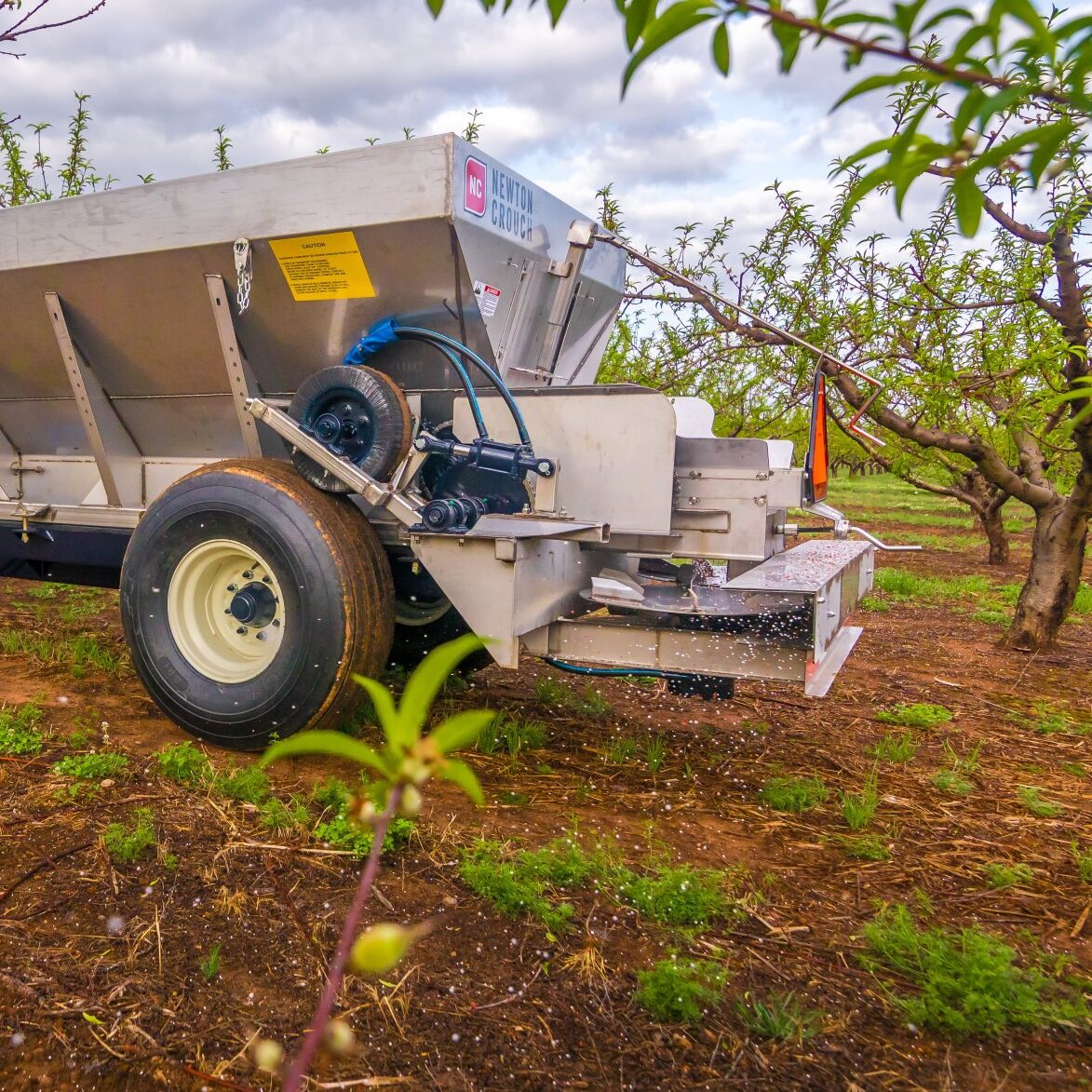
Spreader for Banded Application
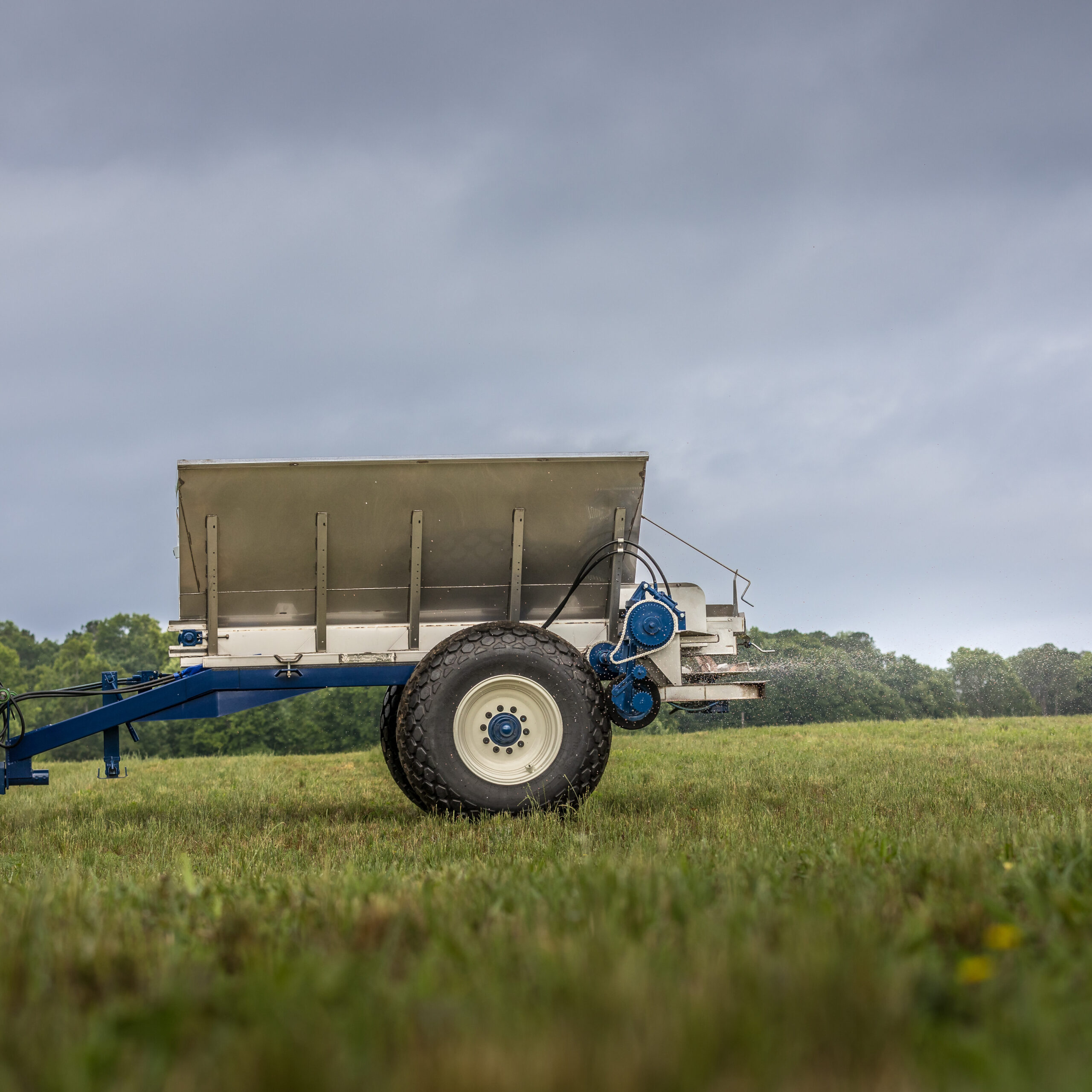
Spreader for Broadcast Application
Spreader Attachment Type: 3-Point, Pull-Type or Truck Mounted?
3-Point Hitch SPreader
- Pros: Compact and easy to maneuver; Excellent for muddy fields, narrow rows, orchards, vineyards, and food plots.
- Cons: Limited capacity (typically under 2 tons); capacity is dependent on tractor size.
Pull-Type Spreader
- Pros: Higher capacity (up to 10 tons); covers more acres between fills.
- Cons: Requires more turning space; not ideal for tight or hilly terrain.
Truck-Mounted SPreader
- Pros: Maximum efficiency for large-scale operators or custom applicators; faster road speeds and refills.
- Cons: Requires a dedicated truck chassis; less flexible for small fields or tight terrain.
Yield Impact:
Your attachment type directly affects uptime, maneuverability, and ability to apply fertilizer during ideal crop growth stages. Small acreage fields benefit from tight turns and fast adjustments, while large acreage operations need fewer fill interruptions to hit application windows. Delays in fertilizer application can miss critical crop stages, particularly in fast-growing annuals like corn or sorghum.
How Newton Crouch Helps:
Newton Crouch 3-Point Hitch Spreader, Model 20, is purpose-built for precision spreading in muddy fields.
Newton Crouch Pull-Type Spreader Models like the Row Crop Series (Models 40 and 49), Tandem Axle Series (Model 47), or the NC Series (Model 48) balance bulk capacity and field efficiency for most row crops and pasture applications.
The Newton Crouch Truck-Mount Spreader (Model 54) is designed for speed, efficiency, and high-acreage throughput, ideal for custom application businesses or large row crop farms.
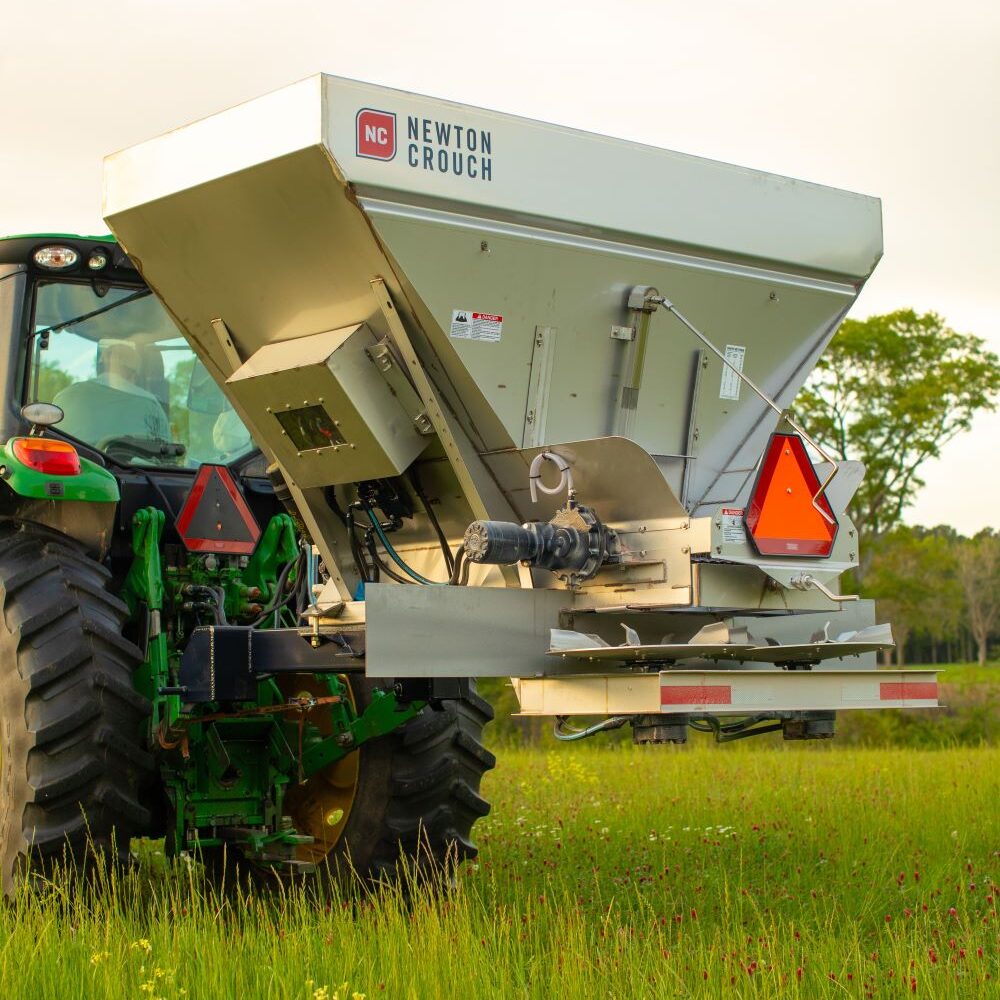
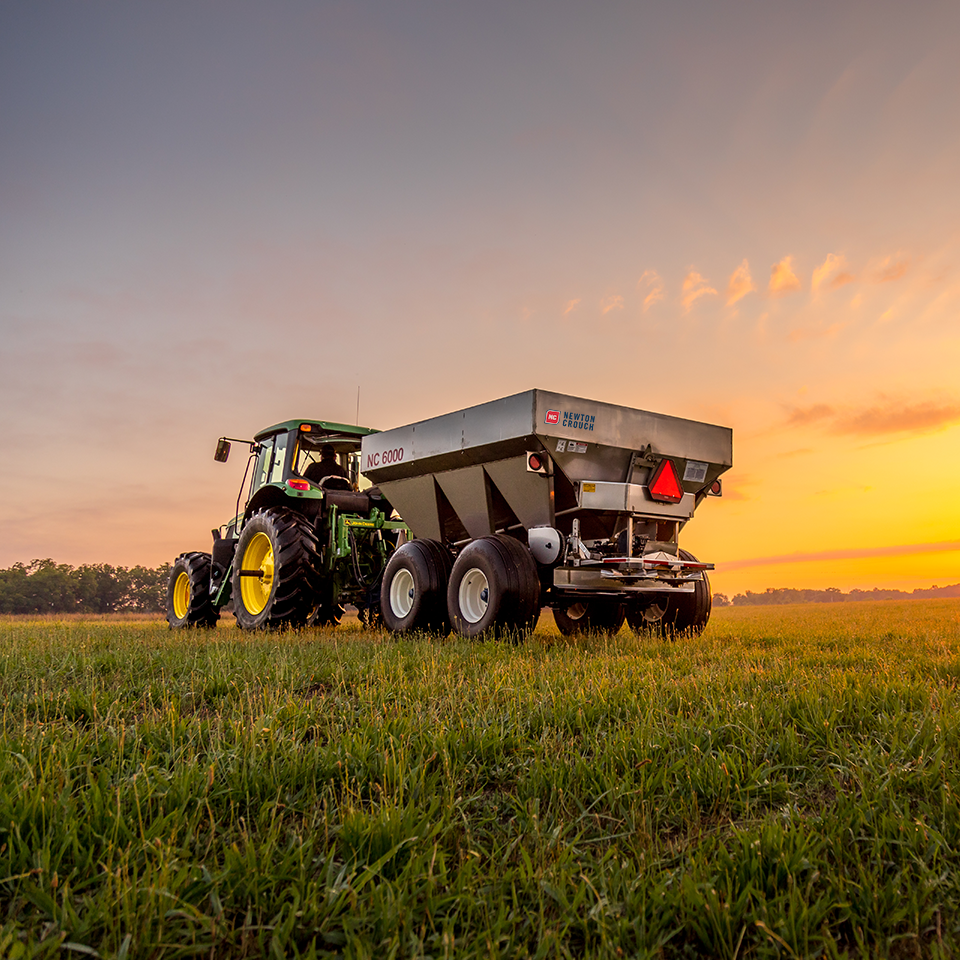
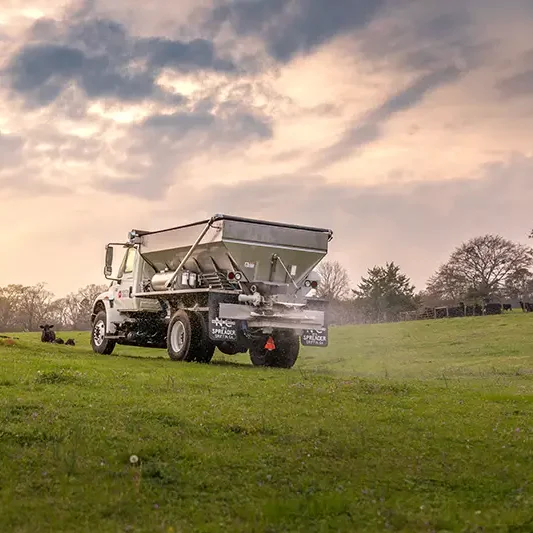
Drive Mechanism: PTO or Hydraulic?
PTO-Driven Spreader
- Pros: Simple, widely compatible; no need for hydraulic remotes.
- Cons: Less fine-tuned control over spinner speed and conveyor rates.
Hydraulic Drive Spreader
- Pros: Offers straight rate, precision, and variable rate control; ideal for integrating with GPS, ISO, and VRT systems.
- Cons: Requires hydraulic capacity; more complex.
Yield Impact:
Hydraulic systems enable site-specific nutrient management – especially critical for variable soils or zone-based nutrient plans. PTO drives can underperform in terms of precision on variable terrain or split applications.
How Newton Crouch Helps:
Newton Crouch offers both options—with VRT-ready hydraulic drives for precision agriculture users, and durable PTO-driven models for simplicity and cost-effectiveness. Paired with a Raven, Trimble, TeeJet, or Micro-Trak controller, hydraulic systems give you real-time rate adjustments in the field.
Longevity of Your Spreader Investment
Newton Crouch Spreaders
- Pros: Built with 304 stainless steel hoppers, powder-coated trailer frames, and a protective Herculiner coating on top. Each spreader is bolted— not welded — to the trailer, making it easy to clean or replace components. With regular maintenance, Newton Crouch spreaders have a realistic service life of 15–20 years.
- Cons: Higher initial investment, but significantly lower long-term replacement and downtime costs.
Competitor Spreader Models
- Pros: Often lower up-front cost. Basic mild steel components reduce manufacturing expense.
- Cons: Susceptible to corrosion, especially when applying urea or ammonium nitrate. Welded frames and painted surfaces tend to deteriorate more quickly in humid or coastal climates, often requiring replacement in 3–7 years.
Yield Impact:
Corroded hoppers, blocked chutes, or warped spinners reduce application accuracy, which directly affects nutrient distribution and plant growth. A poorly maintained or rusted spreader can lead to uneven spreading patterns and yield loss – especially in precision-dependent crops.
How Newton Crouch Helps:
Our spreaders are engineered for longevity in corrosive environments. Our 304 stainless steel hopper, conveyor, and parts resists rust, while the powder-coated trailer and Herculiner coating add multiple layers of protection. Because the hopper is bolted to the trailer, the trailer can be cleaned, replaced, or refurbished without easily and without considerable downtime.
A long-lasting spreader not only lowers your total cost of ownership—it ensures consistent application season after season, year after year.

34 Year Old NC Spreader

8 Year Old NC Spreader
Type of Product Being Applied
Choosing the right spreader starts with knowing what material you’re applying. Each product—whether it’s fertilizer, lime, cover crop seed, or manure—has unique characteristics that affect flow rate, spread pattern, corrosion risk, and yield potential. Selecting the wrong equipment can result in application errors, wasted inputs, or even equipment damage.
Fertilizer Only SPreader:
- Pros: Newton Crouch NC Series is designed specifically for fertilizer application. Its 8″ conveyor and simple design is easy to calibrate for broadcast or banded application and compatible with a wide range of spinner spreaders.
- Cons: Smaller conveyor limits spreading of other products like lime.
Fertilizer Lime Spreader:
- Pros: Spreaders such as Newton Crouch’s Row Crop Series, Tandem Axle Series, Orchard-Vineyard Spreaders, and Truck Spreaders are designed for precise both fertilizer or lime spreading. These spreaders can be customized with a variety of drive systems and conveyor widths, 16″ or 24″ wide, to ensure accurate spreading of material without bridging.
- Cons: Combo spreaders have higher cost up.
Manure Spreader:
- Pros: Newton Crouch litter and manure spreader models include wide rear gates, robust chains, and reinforced spinners that maintain even application—even in wet or chunky materials. Stainless options protect against long-term damage from corrosive organics.
- Cons: Uneven litter or manure application can cause excessive nutrient hotspots or nutrient gaps—both of which reduce crop uniformity and hinder nutrient use efficiency (NUE). Ensure that you use a spreader that can handle the heavy organic product being spread.
Cover Crop Seed Spreader:
- Pros: All Newton Crouch Spreaders can easily adjust swath width and application rate to accommodate lightweight seed in a wide broadcast. Using spreaders to seed for post-harvest ground cover, erosion control, and organic matter improvement allows you to use your spreader during the off peak spreading season.
- Cons: Spreading of seed can be tricky due and can be susceptible to wind.
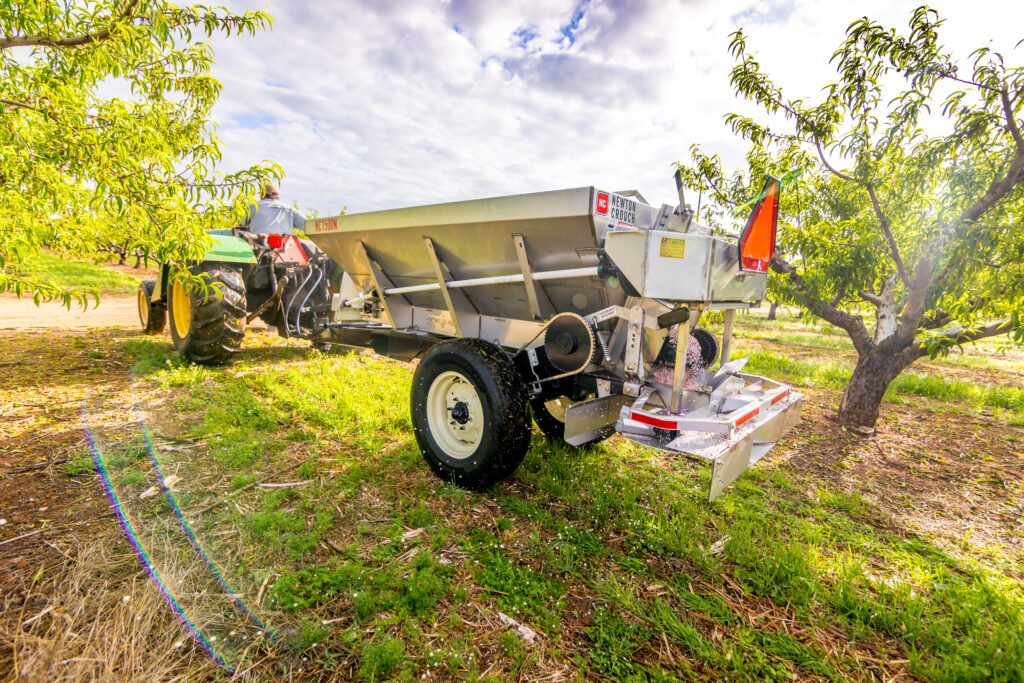
1.5-Ton Fertilizer Spreader
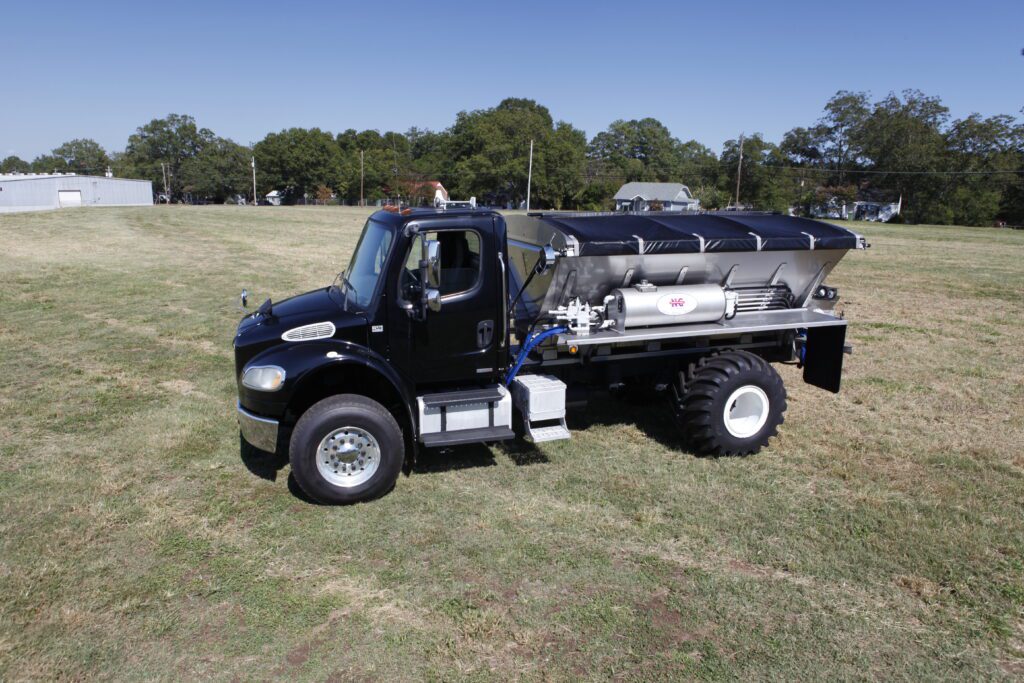
10-Ton Fertilizer/Lime Spreader
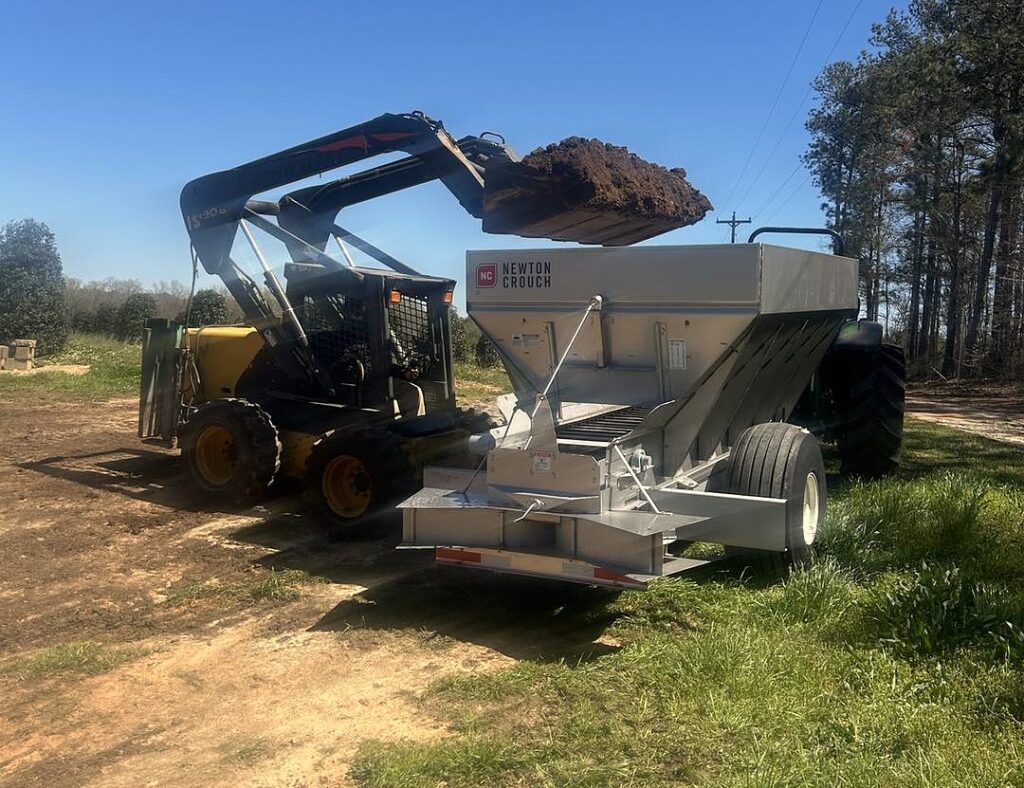
Manure Spreader
Yield Impact:
Using the improper spreader for the material being applied can lead to patchy, uneven spread pattern. Finding the best spreader for the product being applied is key. Even coverage supports better long-term soil health.
How Newton Crouch Helps:
Newton Crouch fertilizer only spreaders feature 304 stainless steel hoppers, conveyor chains, and spinner parts to resist corrosion. Adjustable chute and spinner settings ensure precise application even with blended fertilizer materials. Optional banding attachments support in-furrow or side dress efficiency.
Newton Crouch combo spreaders are designed to handle both fertilizer and lime with heavier-duty conveyors, larger gates, and reinforced spinners. High-capacity models like the Model 47 Tandem Axle Spreaders or Model 54 Truck Spreaders ensure optimal coverage with fewer fill stops. Lime-specific settings prevent bridging and maintain flow rate.
Newton Crouch spreaders feature precision spinner design and flow control that supports lower-rate applications of lightweight seed. Easy to change gate openings and fine conveyor speed adjustments allow accurate metering of small-seeded mixes like ryegrass, clover, or radish.
Field Size: Match Capacity to Acreage
Small Capacity (1.5–2 tons):
- Pros: Easier to load, maneuver; perfect for specialty crops, orchards, or spot treatments.
- Cons: Requires frequent refilling, which can disrupt fieldwork during large-scale operations.
Large Capacity (4–10 tons):
- Pros: Longer runtime; fewer interruptions.
- Cons: Heavier; may compact soil in sensitive fields if not properly managed.
Yield Impact:
Inconsistent spread patterns due to hopper “empty runs” or skipping refills can reduce yields and cause nutrient stress in crops. Efficient runtime helps ensure nutrients are applied at the right stage—particularly important for sidedress or topdress windows.
How Newton Crouch Helps:
With spreaders ranging from 1.5-tons to 10-tons, Newton Crouch ensures you can size your spreader to your operation and reduce refill downtime. Our team helps you balance capacity with tractor compatibility and field access.

1.5-Ton Fertilizer Spreader

10-Ton Fertilizer/Lime Spreader
Make the Agronomic Choice
Choosing a fertilizer spreader is a decision that directly affects plant health, yield, and profitability. Picking a spreader on cost alone is not the best decision for your farm. Your next spreader purchase must match your agronomic needs.
Newton Crouch doesn’t just sell equipment—we build solutions for crop performance. Whether you need a compact, nimble unit for a blueberry farm or a high-capacity VRT-ready spreader for 5,000 acres of corn, we’re here to guide your decision with agronomic expertise.
👉 Explore our full line of fertilizer-only spreaders
👉 Explore our full line of fertilizer-lime combo single axle pull type spreaders
👉 Explore our full line of fertilizer-lime combo tandem axle pull type spreaders
👉 Explore our full line of fertilizer-lime combo 3-point hitch spreaders
👉 Explore our full line of fertilizer-lime combo truck mounted spreaders
Need a quote? Find your closest location or dealers
